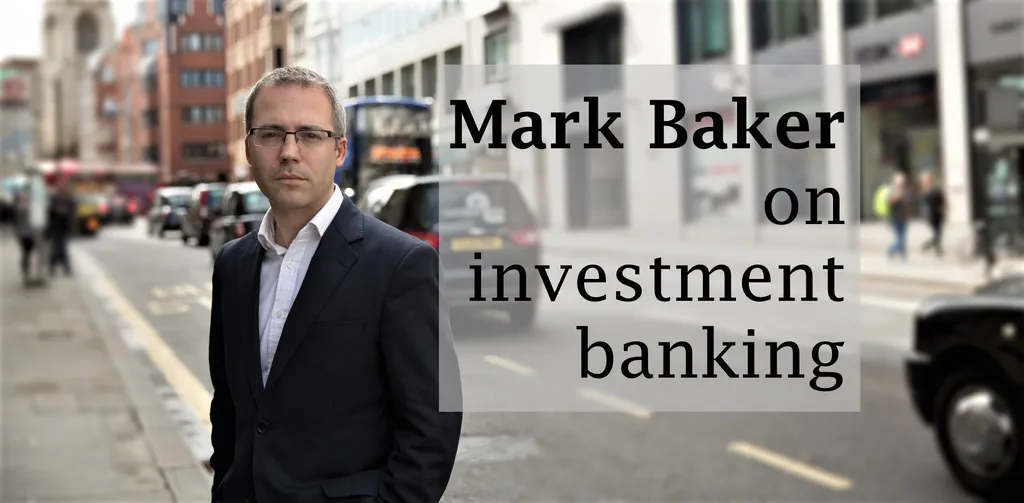Is that it? Did the great leveraged loan crunch end before it really began?
Listening to the US banks present their third-quarter earnings, it was easy to start feeling that way. But then Deutsche Bank pops up with pretty much no origination revenues for the last three months – and perhaps it’s not such a small concern after all.
Not the worst starting point for any finance topic is to look at what JPMorgan chief executive Jamie Dimon might have said about it. So here he is on his bank’s call on October 14: “There were no real leveraged loan write-downs this quarter… Our share of it is very small, so we’re very comfortable.”
For JPMorgan this sounds like it is not a thing, so we should move along? Maybe not. Three months earlier he was a bit more chatty about it all. Back then, the bank was reporting that it had taken about $250 million of markdowns on its bridge book.
Jamie often sounds like he wants us to not be worried but then also worried; perhaps just not worried about JPMorgan. In 2007, as he never tires of telling us, leveraged finance was a gigantic problem, with the entire Street’s bridge book standing at some $500 billion. Now it’s about $100 billion, he says, and so, yes, even JPMorgan is taking some losses, but it’s, you know, manageable:
“Our percent of that bridge brook has come down substantially just in the last 12 months, and that’s really just underwriting loan by loan by loan, and you win some and you lose some. And if you guys look at high-yield spreads and stuff like that, bonds were down 6%, that’s what you see. So you have some flex and we’re big boys, we know that, and there is write-downs of a couple of bridge loans. They’re not huge.”
He might be underplaying it a bit. The volume of outstanding US high-yield bonds and leveraged loans that are trading at distressed levels is at point not seen since before the pandemic. In June, it hit $140 billion, according to JPMorgan data cited by Bruce Karsh, Oaktree Capital Management’s chief investment officer, in a quarterly note to investors.
Expanding universe
Oaktree is in the same ballpark as Dimon on hung bridges: it reckons that there is about $70 billion in the US with additional meaningful volume in Europe. But it also thinks there is a big opportunity on the way in distressed liquid credit.

It notes that outstanding high-yield bonds, BBB-rated bonds, leveraged loans and middle-market direct loans had risen to $12.2 trillion by the summer of 2022, more than four times what it was at the end of 2007.
So, while the bridge book might be smaller, the distressed universe is getting alarmingly big, which is going to hurt attempts to offload debt even more.
Anyway, here is Jamie again on risk management and “the things”.
“The economy will be bigger in 10 years. We’re going to run the company. We’re going to serve more clients. We’re going to open our branches. We’re going to invest in the things, and we’ll manage through that. If you look at what we do, our bridge book is way down. That was managing certain exposures. We’re not in sub-prime fundamentally. That’s managing your exposures. We’re quite careful about how we run the risk of the company, and if there was a reason to cut back on something, we would.”
CFO Jeremy Barnum added that JPMorgan had consciously dialled back its risk appetite and accepted that it would lose market share in leveraged finance – so it sounds like Jamie found “a reason to cut back on something”. And so it also sounds like other folks should be scared.
How’s Jamie doing again?
“Our bridge book is smaller than it was because we priced ourselves out of the market, and that was a good thing because a lot of people will lose a lot of money there, and we lost a little.”
“Thanks, appreciate the thought,” says every other bank chief executive. But still, $250 million on the bridge book is actually nearly the highest quarterly markdown among the big banks in the last two quarters. But, whatever, “a lot of people will lose a lot of money”.
That seems like a reasonable guess in a year that has seen banks lose money on things like Citrix, where underwriting banks lost about $600 million to $700 million in September from selling some $8.55 billion of bonds and loans backing the $16.5 billion leveraged buyout that they had agreed to finance back in January.
Our bridge book is smaller than it was because we priced ourselves out of the market, and that was a good thing because a lot of people will lose a lot of money there, and we lost a little
Jamie Dimon, JPMorgan
Other unpleasantness could come from the likes of Tegna ($4.2 billion bridge), Nielsen ($2 billion bridge) and Twitter ($13 billion in debt financing). The banks backing the Twitter deal are now expected not to bother trying to syndicate the debt until 2023 to avoid crystallizing hundreds of millions of dollars of losses.
Noises off
One problem with parsing the state of play in leveraged finance from earnings is that pretty much no one discloses their actual bridge book; and even their markdowns are what analysts call “noisy”. That means there’s typically a bunch of other stuff mixed in.
Morgan Stanley is one example, putting its net-of-hedges markdowns on corporate loans through the ‘other revenues’ line in its Institutional Securities division alongside losses associated with employee deferred compensation plans, of all things. That line posted revenues of negative $100 million in the third quarter, but it is anyone’s guess how it breaks out. The bank was more forthcoming in the second quarter, when it disclosed a $282 million mark-down.
One analyst on the third quarter call pointed out that the firm seemed to be on a number of hung deals, like Citrix and Twitter. Oddly, chief executive James Gorman first wanted to remind everyone that deals “are not hung deals until they’re actually out there”.
But anyway:
“A little over a year ago, we turned quite conservative… We pulled in a little bit. And we pulled in with our margin book, particularly our Asia margin book. We looked across our whole prime brokerage platform, and we pulled in a little bit with certain clients there. And we’ve been quite cautious in our leveraged finance arena.”
Gorman certainly sounds like he wants to be right up there with Dimon for conservatism, even if his firm is up to its neck in Twitter. But the way he tells it, Citrix certainly isn’t a big deal for him – and neither is anything else by the sound of it.
“Somebody mentioned one transaction, Citrix. We’re actually a small player in that… The aggregate picture is, frankly, it’s just not that troubling.”
Goldman Sachs reported that it had taken markdowns on acquisition financing facilities in both the second and third quarters of the year, although it was only in the second quarter that it disclosed what it was, at $225 million. In the third quarter, the bank’s corporate lending revenue line dropped year on year from $152 million to $35 million, but the numbers cover everything from mid-market lending, transaction banking, portfolio hedges to leveraged lending marks.
At Wells Fargo there was a $107 million write-down on unfunded leveraged finance commitments in the second quarter of the year, but by the third quarter any write-down was being described as “immaterial”.
Citi was equally untroubled, with some $110 million of markdowns on commitments and losses on loan sales in the third quarter of the year, and nothing reported in the second quarter.

There has been a greater interest in the situation at Bank of America, not least because it posted leveraged finance valuation marks of $300 million in the second quarter of the year, the biggest single mark that any of the US banks has reported.
Back then the talk on the BofA earnings call was all about a downturn in leveraged finance markets because of the “market turmoil and abrupt slowdown”. But come the third quarter and there was nothing worth reporting. As CFO Alastair Borthwick told analysts: “We called it out last quarter because it was just bigger. But this quarter, we didn’t feel that we needed to.”
Given that BofA is on the Twitter deal, let’s see what needs to be “called out” in the next few quarters. Borthwick’s boss, chief executive Brian Moynihan, was on TV on October 28 sounding pretty relaxed about the whole thing: “I’ve got experts that handle the clients and I don’t lose sleep on them.”
European lumps
Among the Europeans, Barclays was sounding rather coy back in the second quarter of the year, when analysts were wondering where the bank was setting its marks. CFO Anna Cross soon put them straight: “We haven’t disclosed the marks, that’s not something we have done or will do”.
Things change. In its third-quarter earnings announcement, Barclays duly noted a fair value loss on leveraged finance lending of about £255 million in the first nine months of the year, of which £190 million was taken in the third quarter.
Over at UBS, detail of individual investment banking business lines is patchy these days now that the bank prefers to lump its results together into a capital markets aggregate. But in the third quarter it did note that its leveraged capital markets fees had dropped by 62% year on year.
It said that it was sitting on about $1 billion of loan underwriting commitments that “had not yet been distributed as originally planned as of 30 September 2022,” but it did not disclose a specific markdown for the quarter. In the second quarter of the year, it had reported net mark-to-market losses of just $70 million across its leveraged capital markets, corporate loans and commercial real estate businesses.
And what exactly happened at Deutsche Bank? The bank’s capital markets numbers looked awful, even by its standards, but as usual there’s some unpicking to be done. It reports its investment banking business lines net of markdowns, unlike many peers who tuck them away elsewhere.
So, when Deutsche reports debt capital markets origination revenues of just €6 million for the third quarter of 2022 – yes, you read that right, this is the business that a year earlier had posted revenues of €416 million – what it really means is net of €110 million of markdowns. In the second quarter, it had reported €21 million net of €150 million of marks. It also reduced its commitment pipeline by about 50%.
This isn’t always just a leveraged finance problem, mind you. When your equity capital markets business is as small as Deutsche’s and in a year when the industry collapse in ECM volumes makes mishaps stand out all the more, reporting €2 million of negative revenues in ECM looks embarrassing.

The explanation? “Mark-to-market losses on a residual equity position,” according to CFO James von Moltke on the bank’s third-quarter earnings call, which sounds a lot like a block trade gone bad.
But back to leveraged finance and the bank was noting in its outlook for 2022 that it expected origination and advisory revenues to be much lower in 2022 compared with 2021. That’s hardly a revelation: DCM and ECM revenues combined are down roughly 60% in the year so far.
Deutsche says there could be worse to come, particularly in leveraged finance, but that it should be able to deal with it: “Whilst the Group actively manages systemic risks, it has experienced delays in de-risking individual commitments as well as taken mark-to-market losses in the first nine months of 2022, driven by widening in credit spreads and higher interest rates.
“Although the group has seen losses subside in the third quarter, it expects the fourth quarter to remain challenging and the group could see additional losses. However, downside risk to revenues and capital are considered manageable.”
A little bit of medicine
And what of Credit Suisse, the firm that this week unveiled its long-awaited reorganization, including a revival of the venerable name of CS First Boston for its investment bank, which it is breaking up and carving out?
Leveraged finance has always been an important part of the business – some say that CS First Boston won’t really have much else once you strip out Asia, Switzerland and the markets business. But the bank has been slashing its exposure of late. The bank said that it had fallen from $7.4 billion in the first quarter of the year to $3.6 billion now.
It chalked up a few mark-to-market losses too, with $245 million taken in the second quarter and $120 million in the third quarter.
It could find life tough as it looks to move to a capital-light model for its new independent investment bank. As it recognized in its own announcement: “The capital-light Investment Bank is also likely to face increased competition in areas such as leveraged finance and underwriting, particularly from competitors that have access to larger amounts of capital.”
You don’t say.
Credit Suisse has been a beneficiary of strong periods for leveraged finance in the past. Another is Jefferies, which these days has its own leveraged lending joint venture with MassMutual called Jefferies Finance, as well as an alliance with Sumitomo Mitsui Financial Group that it inked in 2021 and which is partly targeted at expanding its presence in US leveraged finance.
It was a theme that also loomed large at Jefferies’ investor day on October 12, particularly as Jefferies Finance reported a year-to-date loss of $91 million. But as Jefferies president Brian Friedman told investors, Jefferies is taking half that loss on a balance sheet of about $8 billion.
No one is going to disappear because of their exposure
Rich Handler, Jefferies
“Use that math, assuming the rest of the players have a similar type of exposure, and this is not the world coming to an end,” he said.
That’s why chief executive Rich Handler is bullish, arguing that the risks now are of an entirely different nature to the previous shutdown.
“This is nothing like the last time the leveraged finance market was really closed in 2008, when individual banks had $50 billion of hung exposure that were levered on their balance sheet with cockamamie illiquid assets all around it. Now there’s that kind of size on the Street, but it’s spread amongst a lot of players.”
It is much the same message as Dimon has been giving, even if Handler and Friedman need to believe it a little more fervently than their JPMorgan cousins. Everyone is taking a little bit of medicine, said Handler, but the situation was not a game changer.
“No one is going to disappear because of their exposure.”




